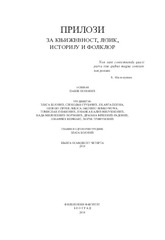Приказ основних података о документу
Увод приручника из реторике Мануила Козачинског
The Prоеm of the Rhetoric Textbook by Manuil Kozačinski
| dc.creator | Ristović, Nenad | |
| dc.date.accessioned | 2023-10-16T11:55:37Z | |
| dc.date.available | 2023-10-16T11:55:37Z | |
| dc.date.issued | 2018 | |
| dc.identifier.issn | 0350–6673 | |
| dc.identifier.uri | http://reff.f.bg.ac.rs/handle/123456789/4993 | |
| dc.description.abstract | У раду се презентује и контекстуализује непроучавани рукопис Увода приручника из реторике Мануила (Михаила) Козачинског (око 1700–1755) писан на латинском језику 1735. године. Указује се на модер- низацијски асpект који је имало увођење реторике у српски образовни простор, објашњава се како је оно било израз нове културне политике православне јерархије изнуђене околностима католичког прозелитизма те се закључује да је императивно ширење реторике постало један од кључних елемената акултурације Срба Хабзбуршке монархије у западну нововековну културу. | sr |
| dc.description.abstract | The paper presents unstudied source for the 18th century Serbs’ cultural history, written in Latin in 1735. It is the Proemium of the first Serbian rhetoric textbook by Manuil (Mihail) Kozačinski. The focus of this research is in the context of this unique manuscript testimony of the beginning of modern rhetoric teaching among the Serbs in the grammar school in Karlovci. The introduction of modern Western rhetoric was revolutionary step in the process of educational modernization of the Serbs in the Habsburg monarchy so that the first lines of Kozačinski’s introductory lesson underline the very fact of starting rhetoric teaching. This teaching was the central element of contemporary Western secondary education based on humanistic rediscovery of the value of the classical rhetoric. Kozačinski presented rhetoric in usual humanistic way, following Cicero’s and Quintilian’s views. On the other hand his words reflect the other side of rhetoric in early modern Western society: rhetoric was used as a mighty weapon in religious polemics in post-Reformation Europe. The Orthodox clergy in the Monarchy naturally saw the importance and potential of rhetoric education in preserving religious identity and considered it an imperative in the Church educational policy. The main reason why rhetoric became the basis of Serbian cultural transformation was not primarily the wish for educational development but the fear of the proselytism of the Catholic Church. Serbian clergy was not on the intellectual level necessary in such circumstances and above all it lacked the rhetorical knowledge and skill. Thus the emphasis of the opening words of Kozačinski’s rhetoric textbook is on its utilitas and consequently on the persuasio as its essence. | en |
| dc.language.iso | sr | sr |
| dc.publisher | Београд : Универзитет у Београду – Филолошки факултет | sr |
| dc.rights | openAccess | |
| dc.rights.uri | https://creativecommons.org/licenses/by/4.0/ | |
| dc.source | Прилози за књижевност, језик, историју и фолклор | sr |
| dc.subject | српска култура XVIII столећа | sr |
| dc.subject | Мануил (Михаил) Козачински | sr |
| dc.subject | реторика | sr |
| dc.subject | класично школство | sr |
| dc.subject | образовна модернизација | sr |
| dc.subject | акултурација | sr |
| dc.subject | 18th-century Serbs' culturе | en |
| dc.subject | Manuil (Mihail) Kozačinski | en |
| dc.subject | rhetoric | en |
| dc.subject | educational modernization | en |
| dc.subject | acculturation | en |
| dc.title | Увод приручника из реторике Мануила Козачинског | sr |
| dc.title | The Prоеm of the Rhetoric Textbook by Manuil Kozačinski | en |
| dc.type | article | |
| dc.rights.license | BY | |
| dc.citation.epage | 62 | |
| dc.citation.rank | M24 | |
| dc.citation.spage | 48 | |
| dc.citation.volume | 84 | |
| dc.identifier.doi | 10.2298/PKJIF1884047R | |
| dc.identifier.fulltext | http://reff.f.bg.ac.rs/bitstream/id/12275/Kozachinsky.pdf | |
| dc.type.version | publishedVersion | |
| dc.identifier.cobiss | 531132823 |

